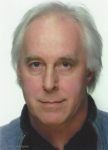Study 24: Higher quality of life in the U.S. (1960-1983)
In 1973 the Transcendental Meditation organisation founded its own university, which purchased a university campus in 1975 from another private education institute in the village of Fairfield in the state of Iowa in the U.S. A community of Yogic Flyers developed around the university, people from all over the U.S. moved to this small village to together practice their TM, TM sidhi programme and Yogic Flying. From early 1980 onwards the group was so large that the influence, combined with the millions of individual TM practitioners, was big enough to reach everyone in the U.S. (1520 Yogic Flyers according to the square root of the 1% formula).
In order to test this, the researchers compiled an index of the Quality of Life comprising several variables that would normally be uncorrelated, and considered whether the TM and Yogic Flying practice had a noticeable influence on the index. The following 12 social variables were incorporated into the index:
- Number of crimes
- Number of civil court cases
- Number of infectious diseases
- Number of child deaths
- Number of suicides
- Number of cigarettes per capita
- Alcohol consumption per capita
- Gross National Product per capita
- Number of patent applications
- Number of diplomas issued per capita
- Number of divorces
- Number of fatal traffic accidents
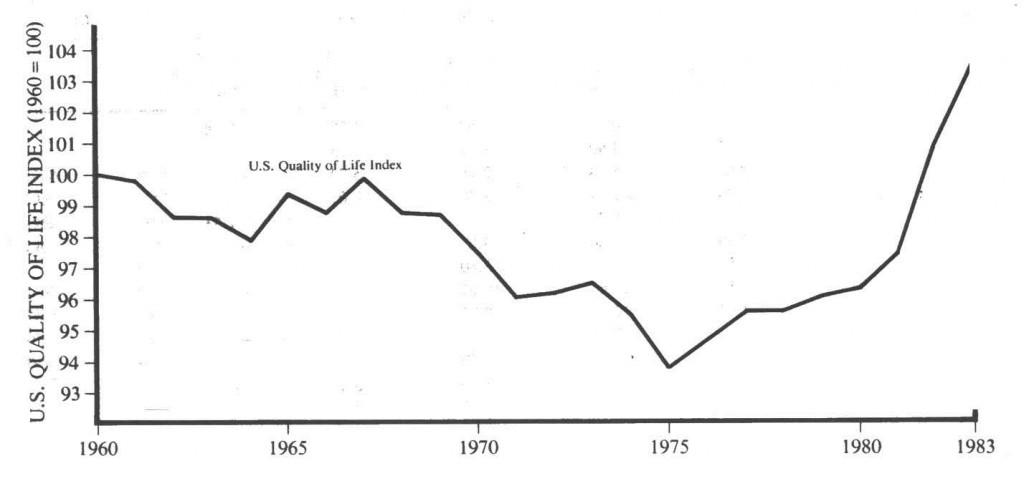
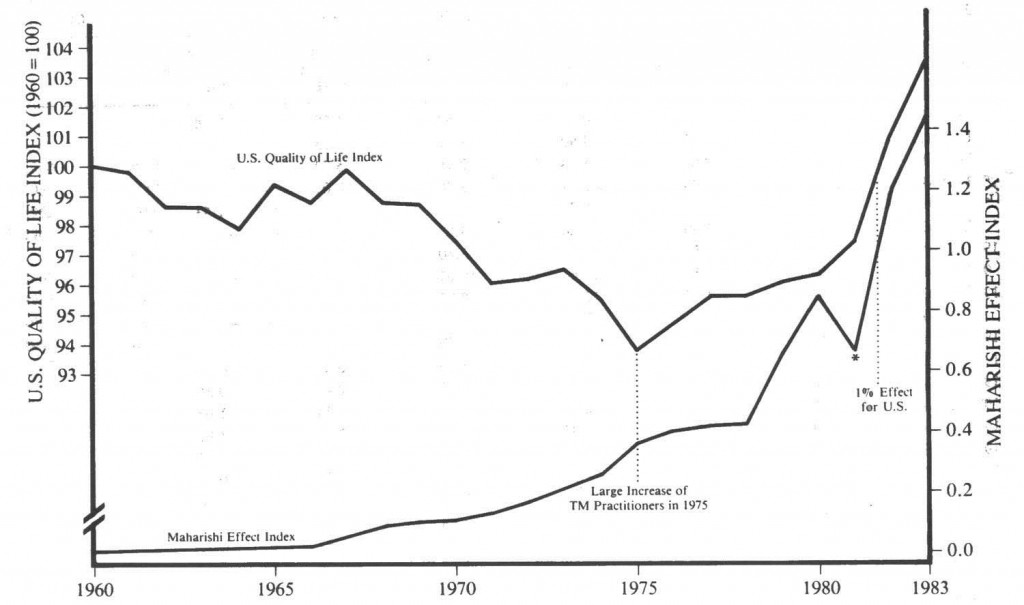
The reversal in the quality of life index appears to coincide with a large increase in the number of TM practitioners in the U.S. But the correlation between the number of Yogic Flyers in Fairfield, responsible for the strong increase in the Maharishi effect index from 1980, and the quality of life index, appeared to be much stronger (p<.0001). From a casual statistic analysis of the numbers, they were able to say with a large degree of certainty that the increase of the Maharishi-effect index was the cause of the increase in the Quality of Life index (p<.0001). According to statistical calculations, increases in the Quality of Life index from 1981 to 1983 could be ascribed to the Maharishi-effect.
When we look at the twelve variables, we get a much better idea of what this significant increase in the quality of life index means. From the 12 variables, 11 showed a significant improvement (only the number of suicides did not improve), and in 7 records were broken.
Crime: From 1981 to 1983 the number of crimes decreased in three consecutive years, something that had never happened before (-0.78% in ’81, -4.3% in ’82, and -7.6% in ’83). This meant 1.300.000 fewer crimes in 1982 and 1983, principally created by the 1600 Yogic Flyers.
Civil court cases: Due to a degree of harmony in the collective conscious, civil suits were only filed when all other amicable methods to solve conflicts have failed. The number decreased by 7.6 % in 1982 and another 11.5 % in ’83, reaching the lowest number ever reported.
Infectious diseases: Decreased by 4.23% in ’82 and by 7.02 % in ‘83 (strongest decrease in 16 years)
Cigarette usage : Decreased by 1.90 % in ’82 and 6.26 % in ’83 (biggest decrease in the 23 years of the study.)
Alcohol usage: Decreased by 3.52 % in ’82 and 2.64 % in ‘83. (second and third largest decreases in 23 years)
Number of diplomas issued: increased slightly (0.31% and 0.98%) after decrease in the previous five years
Divorces: Decreased by 4.46 % in 1982 (a decrease 3 times bigger than the previous record set 21 years earlier) and another 0.18 % in 1983 (the only time that the number of divorces decreased two years in a row)
Fatal accidents: Decreased 10.95 % in 1982 (biggest decrease ever, apart from 1975, when the 55 mph speed limit was introduced in the U.S.). The prominent magazine Motor Trend wrote at the end of 1982:
“Everyone loves a mistery, and the sudden 10% drop in 1982 highway fatalities has created a good one. Various sources postulate reasons for the decline…but the fact is, nobody knows why”
The magazine and other car organisations predicted an increase for the subsequent year, but another decrease in the number of car accidents of 4.60% was reported in 1983.
In order to provide an extra argument that the increase in the Quality of Life index from 1981 to 1983 was in fact due to the group of Yogic Flyers in Iowa, the numbers for the U.S. as a whole were compared to the numbers for Iowa. One source of light can illuminate an entire room (or an entire country), but the light will always shine brightest closest to the light source. Accordingly, a stronger improvement was predicted for Iowa than for the U.S. in general, a predicted that was confirmed by the numbers.Ref.Social Science Perspectives Journal, (2 (4), 127-146)
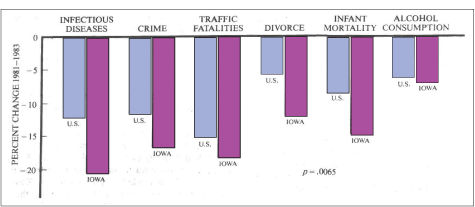
Social effects of Yogic Flying studied.
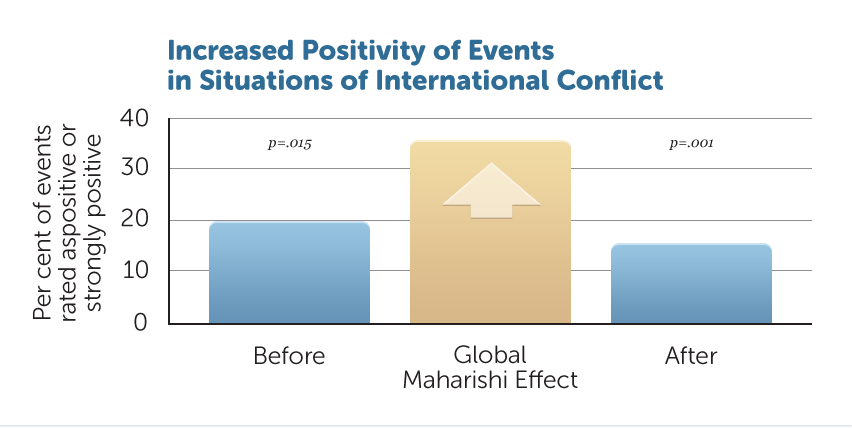 During the three-week period of the Taste of Utopia Assembly, compared to the three-week period before the Assembly, the balance of negativity to positivity in events pertaining to international conflicts in the trouble-spot areas of the world shifted significantly towards increased positivity, as indicated by content analysis of the news. In the three-week period after the assembly the balance of events reverted towards the previous condition of increased negativity. Such trends were not found during the same time the previous year.Ref.Scientific Research on Maharishi’s Transcendental Meditation and TM-Sidhi Programme: Collected Papers (Vol. 4, 1989, pp. 2730–2762)
During the three-week period of the Taste of Utopia Assembly, compared to the three-week period before the Assembly, the balance of negativity to positivity in events pertaining to international conflicts in the trouble-spot areas of the world shifted significantly towards increased positivity, as indicated by content analysis of the news. In the three-week period after the assembly the balance of events reverted towards the previous condition of increased negativity. Such trends were not found during the same time the previous year.Ref.Scientific Research on Maharishi’s Transcendental Meditation and TM-Sidhi Programme: Collected Papers (Vol. 4, 1989, pp. 2730–2762)
Social effects of Yogic Flying studied.
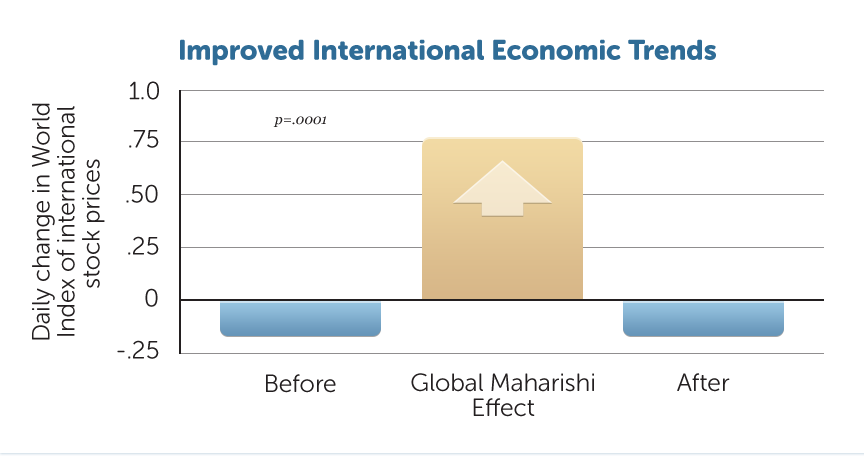 During the three-week period of an assembly participants in the TM Sidhi Programme, numbering more than the square root of one per cent of the world’s population, international economic trends improved compared to the combined periods before and after the assembly, as measured by the World Index of international stock prices.Ref.Scientific Research on Maharishi’s Transcendental Meditation and TM-Sidhi Programme: Collected Papers, Volume 4: 2730–2762, 1989
During the three-week period of an assembly participants in the TM Sidhi Programme, numbering more than the square root of one per cent of the world’s population, international economic trends improved compared to the combined periods before and after the assembly, as measured by the World Index of international stock prices.Ref.Scientific Research on Maharishi’s Transcendental Meditation and TM-Sidhi Programme: Collected Papers, Volume 4: 2730–2762, 1989
Social effects of Yogic Flying studied.
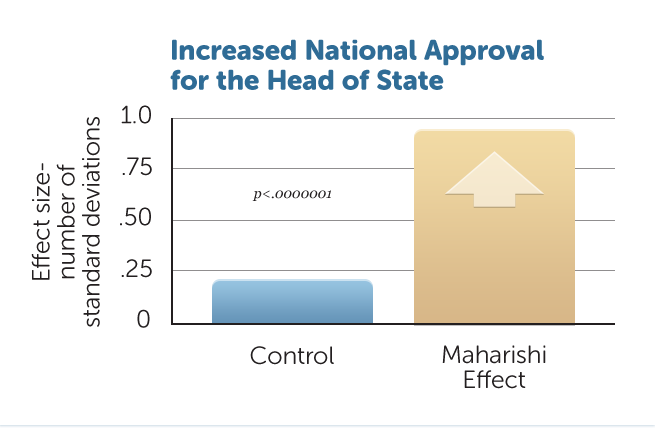 Increased approval ratings for the U.S. Head of State were found when a large group of participants in the TM Sidhi Programme was established. This effect was replicated during three presidential administrations.Ref.‘Transforming political institutions through individual and collective consciousness: The Maharishi Effect and government’. Paper presented at the annual meeting of the American Political Science Association, Washington, D.C., August 1997
Increased approval ratings for the U.S. Head of State were found when a large group of participants in the TM Sidhi Programme was established. This effect was replicated during three presidential administrations.Ref.‘Transforming political institutions through individual and collective consciousness: The Maharishi Effect and government’. Paper presented at the annual meeting of the American Political Science Association, Washington, D.C., August 1997
消極思想減少
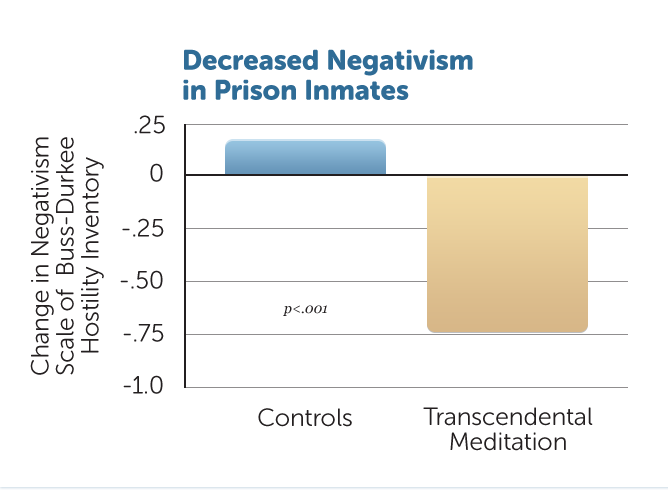 與對照組比較,學習了超覺靜坐技術的高度設防監獄受刑人的消極思想降低。 註.《罪犯司法與行為》Criminal Justice and Behavior 5: 3–20, 1978
與對照組比較,學習了超覺靜坐技術的高度設防監獄受刑人的消極思想降低。 註.《罪犯司法與行為》Criminal Justice and Behavior 5: 3–20, 1978
More positivity
 The practice of the Transcendental Meditation Technique was found to foster increased positivity of cognitive style, as measured by a selective recognition task. A cross-sectional study found higher positivity among participants in the Transcendental Meditation Programme than in controls who were waiting to start the practice. A second longitudinal study found an increase in positivity among those who learned the practice after 14 weeks.Ref.Y. Sakairi. What does meditation change? Measurement of cognitive styles. In The embodiment of mind: Eastern and western perspectives. Delft: Eburon Publishers, 1998, pp. 57–66
The practice of the Transcendental Meditation Technique was found to foster increased positivity of cognitive style, as measured by a selective recognition task. A cross-sectional study found higher positivity among participants in the Transcendental Meditation Programme than in controls who were waiting to start the practice. A second longitudinal study found an increase in positivity among those who learned the practice after 14 weeks.Ref.Y. Sakairi. What does meditation change? Measurement of cognitive styles. In The embodiment of mind: Eastern and western perspectives. Delft: Eburon Publishers, 1998, pp. 57–66























